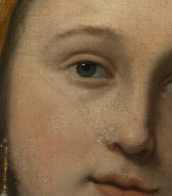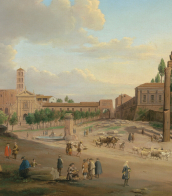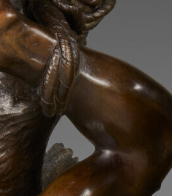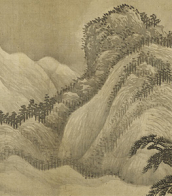633
_-_(by_Lodewijk_van_der_Helst,_1672).jpg)
Willem van de Velde the Younger was a Dutch marine painter from the van de Velde dynasty of artists.
Willem van de Velde the Younger is famous for his paintings depicting the calm sea with a magical reflection of the water surface and sea battles. His works are held in London's National Gallery and private English collections, Amsterdam's Rijksmuseum, The Hague, Berlin, Munich, Vienna and Paris. There are three paintings by Willem van de Velde the Younger in the Hermitage. In addition to paintings, he left many drawings, the number of which exceeds 8,000.

_-_(by_Lodewijk_van_der_Helst,_1672).jpg)
Willem van de Velde the Younger was a Dutch marine painter from the van de Velde dynasty of artists.
Willem van de Velde the Younger is famous for his paintings depicting the calm sea with a magical reflection of the water surface and sea battles. His works are held in London's National Gallery and private English collections, Amsterdam's Rijksmuseum, The Hague, Berlin, Munich, Vienna and Paris. There are three paintings by Willem van de Velde the Younger in the Hermitage. In addition to paintings, he left many drawings, the number of which exceeds 8,000.

_-_(by_Lodewijk_van_der_Helst,_1672).jpg)
Willem van de Velde the Younger was a Dutch marine painter from the van de Velde dynasty of artists.
Willem van de Velde the Younger is famous for his paintings depicting the calm sea with a magical reflection of the water surface and sea battles. His works are held in London's National Gallery and private English collections, Amsterdam's Rijksmuseum, The Hague, Berlin, Munich, Vienna and Paris. There are three paintings by Willem van de Velde the Younger in the Hermitage. In addition to paintings, he left many drawings, the number of which exceeds 8,000.

_-_(by_Lodewijk_van_der_Helst,_1672).jpg)
Willem van de Velde the Younger was a Dutch marine painter from the van de Velde dynasty of artists.
Willem van de Velde the Younger is famous for his paintings depicting the calm sea with a magical reflection of the water surface and sea battles. His works are held in London's National Gallery and private English collections, Amsterdam's Rijksmuseum, The Hague, Berlin, Munich, Vienna and Paris. There are three paintings by Willem van de Velde the Younger in the Hermitage. In addition to paintings, he left many drawings, the number of which exceeds 8,000.


Jacob Biltius or Jacobus Biltius was a Dutch still life painter originally from The Hague who worked in various places including The Hague, Amsterdam, Maastricht, Antwerp, Leeuwarden and Bergen op Zoom. He was known for his game still lifes, kitchen still lifes and trompe-l'œil still lifes.

_-_(by_Lodewijk_van_der_Helst,_1672).jpg)
Willem van de Velde the Younger was a Dutch marine painter from the van de Velde dynasty of artists.
Willem van de Velde the Younger is famous for his paintings depicting the calm sea with a magical reflection of the water surface and sea battles. His works are held in London's National Gallery and private English collections, Amsterdam's Rijksmuseum, The Hague, Berlin, Munich, Vienna and Paris. There are three paintings by Willem van de Velde the Younger in the Hermitage. In addition to paintings, he left many drawings, the number of which exceeds 8,000.


Jacob Biltius or Jacobus Biltius was a Dutch still life painter originally from The Hague who worked in various places including The Hague, Amsterdam, Maastricht, Antwerp, Leeuwarden and Bergen op Zoom. He was known for his game still lifes, kitchen still lifes and trompe-l'œil still lifes.


Willem Drost was a notable Dutch Golden Age painter and printmaker known for his history paintings and portraits. His journey through the art world led him from his birthplace in Amsterdam to the vibrant cultural scene of Venice, where he spent his final years. Drost's work, particularly influenced by his time as one of Rembrandt's most gifted pupils, showcases a mastery of Baroque style, characterized by dramatic use of light and shadow, and a focus on realism and emotional depth.
Despite the relatively small number of works directly attributed to Drost, his legacy is significant, with several of his paintings having been mistakenly attributed to Rembrandt for centuries. This confusion underscores Drost's skill in emulating Rembrandt's style so closely that discerning between the master's and the pupil's work became a subject of scholarly investigation. Among Drost's known pieces, "Bathsheba" (1654), held at the Louvre, stands out for its sensuous portrayal of the biblical figure, showcasing Drost's ability to capture the nuanced interplay of light and shadow, as well as the psychological complexity of his subjects.
Drost's contribution to the Dutch Golden Age of painting is now more clearly recognized, with artworks such as "The Polish Rider," once thought to be by Rembrandt, suggested by some scholars as possibly being his work. While controversial, this reevaluation of Drost's contributions highlights the ongoing discussion about attribution within the art community and the importance of pupils in the studios of great masters like Rembrandt.
For collectors and experts in art and antiques, Willem Drost offers a fascinating glimpse into the world of the Dutch Golden Age, where the lines between master and pupil blur in the shared pursuit of artistic excellence. His works, housed in museums like the Ashmolean Museum in Oxford, the Metropolitan Museum of Art in New York City, and The Wallace Collection in London, continue to captivate audiences with their beauty and emotional depth.
To stay informed about new discoveries, sales, and auction events related to Willem Drost, signing up for updates from art galleries and auction houses is recommended. This ensures access to the latest information and opportunities to engage with the works of this remarkable artist who played a vital role in the legacy of the Dutch Golden Age.

_-_(by_Lodewijk_van_der_Helst,_1672).jpg)
Willem van de Velde the Younger was a Dutch marine painter from the van de Velde dynasty of artists.
Willem van de Velde the Younger is famous for his paintings depicting the calm sea with a magical reflection of the water surface and sea battles. His works are held in London's National Gallery and private English collections, Amsterdam's Rijksmuseum, The Hague, Berlin, Munich, Vienna and Paris. There are three paintings by Willem van de Velde the Younger in the Hermitage. In addition to paintings, he left many drawings, the number of which exceeds 8,000.

_-_(by_Lodewijk_van_der_Helst,_1672).jpg)
Willem van de Velde the Younger was a Dutch marine painter from the van de Velde dynasty of artists.
Willem van de Velde the Younger is famous for his paintings depicting the calm sea with a magical reflection of the water surface and sea battles. His works are held in London's National Gallery and private English collections, Amsterdam's Rijksmuseum, The Hague, Berlin, Munich, Vienna and Paris. There are three paintings by Willem van de Velde the Younger in the Hermitage. In addition to paintings, he left many drawings, the number of which exceeds 8,000.

_-_(by_Lodewijk_van_der_Helst,_1672).jpg)
Willem van de Velde the Younger was a Dutch marine painter from the van de Velde dynasty of artists.
Willem van de Velde the Younger is famous for his paintings depicting the calm sea with a magical reflection of the water surface and sea battles. His works are held in London's National Gallery and private English collections, Amsterdam's Rijksmuseum, The Hague, Berlin, Munich, Vienna and Paris. There are three paintings by Willem van de Velde the Younger in the Hermitage. In addition to paintings, he left many drawings, the number of which exceeds 8,000.

_-_(by_Lodewijk_van_der_Helst,_1672).jpg)
Willem van de Velde the Younger was a Dutch marine painter from the van de Velde dynasty of artists.
Willem van de Velde the Younger is famous for his paintings depicting the calm sea with a magical reflection of the water surface and sea battles. His works are held in London's National Gallery and private English collections, Amsterdam's Rijksmuseum, The Hague, Berlin, Munich, Vienna and Paris. There are three paintings by Willem van de Velde the Younger in the Hermitage. In addition to paintings, he left many drawings, the number of which exceeds 8,000.


Willem Drost was a notable Dutch Golden Age painter and printmaker known for his history paintings and portraits. His journey through the art world led him from his birthplace in Amsterdam to the vibrant cultural scene of Venice, where he spent his final years. Drost's work, particularly influenced by his time as one of Rembrandt's most gifted pupils, showcases a mastery of Baroque style, characterized by dramatic use of light and shadow, and a focus on realism and emotional depth.
Despite the relatively small number of works directly attributed to Drost, his legacy is significant, with several of his paintings having been mistakenly attributed to Rembrandt for centuries. This confusion underscores Drost's skill in emulating Rembrandt's style so closely that discerning between the master's and the pupil's work became a subject of scholarly investigation. Among Drost's known pieces, "Bathsheba" (1654), held at the Louvre, stands out for its sensuous portrayal of the biblical figure, showcasing Drost's ability to capture the nuanced interplay of light and shadow, as well as the psychological complexity of his subjects.
Drost's contribution to the Dutch Golden Age of painting is now more clearly recognized, with artworks such as "The Polish Rider," once thought to be by Rembrandt, suggested by some scholars as possibly being his work. While controversial, this reevaluation of Drost's contributions highlights the ongoing discussion about attribution within the art community and the importance of pupils in the studios of great masters like Rembrandt.
For collectors and experts in art and antiques, Willem Drost offers a fascinating glimpse into the world of the Dutch Golden Age, where the lines between master and pupil blur in the shared pursuit of artistic excellence. His works, housed in museums like the Ashmolean Museum in Oxford, the Metropolitan Museum of Art in New York City, and The Wallace Collection in London, continue to captivate audiences with their beauty and emotional depth.
To stay informed about new discoveries, sales, and auction events related to Willem Drost, signing up for updates from art galleries and auction houses is recommended. This ensures access to the latest information and opportunities to engage with the works of this remarkable artist who played a vital role in the legacy of the Dutch Golden Age.


Frederik de Moucheron the Elder was a Dutch landscape painter of the Dutch Golden Age.
Frederik studied under Jan Asselain (1610-1652), then spent three years in Paris before settling in Amsterdam in 1659. De Moucheron painted French, Italian and Dutch landscapes, reproducing with particular care the effects of sunset and gray clouds. Works by this artist are represented in many European art galleries, such as those in St. Petersburg and the Dresden Gallery.
He was the father of the landscape painters Isak de Moucheron and Frederik de Moucheron the Younger.

_-_(by_Lodewijk_van_der_Helst,_1672).jpg)
Willem van de Velde the Younger was a Dutch marine painter from the van de Velde dynasty of artists.
Willem van de Velde the Younger is famous for his paintings depicting the calm sea with a magical reflection of the water surface and sea battles. His works are held in London's National Gallery and private English collections, Amsterdam's Rijksmuseum, The Hague, Berlin, Munich, Vienna and Paris. There are three paintings by Willem van de Velde the Younger in the Hermitage. In addition to paintings, he left many drawings, the number of which exceeds 8,000.


Marcello Morandini is an Italian architect, sculptor and graphic designer. His visual style involves assembling of repetitive simple forms, often in just black and white, into complex objects.


Marcello Morandini is an Italian architect, sculptor and graphic designer. His visual style involves assembling of repetitive simple forms, often in just black and white, into complex objects.








































































